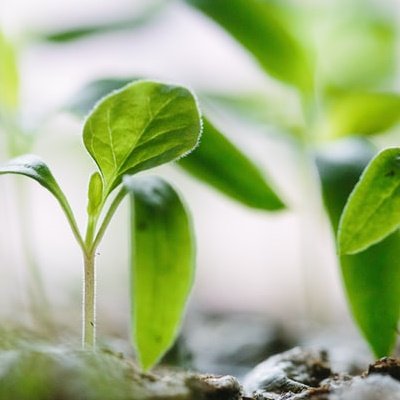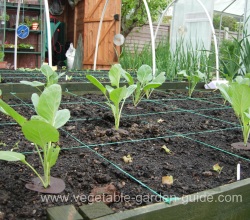Vegetable Gardening Questions
Of A General Nature

Vegetable Gardening Questions - NOTE: Sorry but VGG CANNOT accept questions which need a reply - there are just too many. The formation of this list of questions and answers regarding vegetable garden questions is to meet this need so please help build it - it's a resource for you.
Click here to learn more about helping others with their vegetable gardening questions...

Vegetable Gardening Questions - General
| I'm planting a vegetable garden! Where is the ideal site? |
For planting vegetables an open site is the ideal. The majority of vegetable plants need to be in the sun for as much of the day as possible - away from the shade of buildings and trees etc. Nor should they be too exposed as winds prevent growing vegetables from developing as well as they might. Wind breaks can be erected or grown - keeping in mind shade problems.
On a sloping site work across the slope and not down to limit the possibility of soil erosion.
Poor draining sites are usually unsuitable for vegetable growing unless the drainage is improved.
 |
 |
| Why is it important to rotate my vegetable crops each season? |
The reason for growing particular varieties of vegetable plants in different parts of your vegetable garden each season is that soil pests, like eelworm and clubroot for example, are hard to control. They tend to attack vegetable plants from the same botanical family (eg. clubroot affects cauliflower and cabbage which belong to the Brassica family).
When they are grown over a number of years in the same area of your vegetable garden, you can get a very serious build-up of these pests and diseases.
The four major groups of vegetables to rotate are:
- Brassicas - brussels sprouts, kale, cabbage, cauliflowers, broccoli, Chinese cabbage, turnips, swedes etc.)
- Onions - garlic, leeks, shallots etc.
- Potatoes and Tomatoes
- Legumes - beans, peas.
It is good vegetable gardening practice - where possible, to grow these vegetables in the same area only one year in three, some commentators would advocate four. This will minimise the build up of unwanted vegetable garden dwellers and maximise your vegetable crops.
Remember this is something to aim for but may not always be achievable. Don't give up or become despondent you will succeed with what you have in place for growing vegetables - just be aware, observe and take precautions.
 |
 |
| I'm new to vegetable gardening. What size should my vegetable plot be? |
In the past growing vegetables in long rows was the norm. These rows could be up to 9m(30ft) in length and as many as the garden area allowed. The spacing between the rows was excessive and wasteful.
Today vegetables are grown closer together (without effecting their yield) than those traditional ways and in many instances growing in rows is not practiced at all in favour of equal spacing around plants.
Because of this compactness, smaller, narrower vegetable beds of 1.2m(4ft) and any length are popular. They are pleasing to look at and easy to work on. All the work can be carried out from the path on either side of the bed without treading on the growing area.
They are easily covered in polythene or fleece.
Vegetable gardening questions - raised garden beds example
| What kind of soil is best for growing vegetables in? |
Planting vegetables into a medium loam is the ideal environment for growing healthy and vigorous plants.
Medium loam is an average soil type with a good balance between being very productive - good nutrient content and ability to hold moisture and air, whilst giving it the minimum of attention - feeding, adding compost, improving drainage etc.
But... worry yourself not, as ever, your looking to achieve the ideal over time but working adequately with what you have.
Vegetables will grow in a many types of soils, from light sandy types to heavy clays, it's their fertility that is important!
Vegetables growing in poor, starved soils will never do well. Why!... because just like you after a hard day on your veg plot - they're greedy. Digging in plenty of well rotted manure or compost is the best way to make your soil fertile.
Using a receptacle about the size of a bucket aim to add about a couple of these per square metre/yard per year. Several things happen here:
- The compost/manure is broken down by soil bacteria (millions of them in a teaspoon of soil) into humus from which plant nutrients are released.
- Humus, in turn, makes light (sandy) soils more moisture retentive and improves the drainage of heavy (clay) soils.
- Humus increases the amount of air in the soil.
- Encourages worm activity which are essential for soil fertility.
 |
 |
| What are the effects of soil acidity on vegetable plants? |
In most areas of Britain the soil is slightly acid. The acidity or alkalinity of any soil is measured on the pH scale, but don`t concern yourself with why - it's just a mathematical calculation.
All you need to be concerned with when growing vegetables is what ranges various types of vegetables come under. The pH scale ranges from 0 to 14, with a pH reading of 7.0 being neutral. Above 7.0 is becoming more alkaline and below is becoming more acid.
EXAMPLE: A pH of 5.0 is 10x more acid than a pH of 6.0. A pH of 9.0 is 10x more alkaline than a pH of 8.0 - get it... good, now forget it and concentrate on planting vegetables. Just remember to feed your soil with plenty of well rotted organic matter and they will grow - just aim for just above or below the neutral number of 7.0 - if you really do want to take measurements.
So... for this vegetable gardening question, examples of vegetables that prefer a slightly acid soil (pH 5.5 to 7.0) are: cabbage, brussels sprouts, cucumber, beans, parsnip, parsley, marrows, radish, turnip, sweet corn, tomato, carrots, rhubarb, etc.
| What is inorganic and organic fertiliser? |
Organic fertiliser is 'natural' - derived from plants and animals. The majority of inorganic fertilisers are man-made.
For ease of understanding, plant fertiliser can be sub-divided into bulky manures and concentrated fertilisers.
Bulky manures are all organic manures and are essential for keeping the soil in good condition. These organic manures release their nutrients slowly for your vegetable plants to feed on during their growing life-cycle.
The man-made fertilisers are mostly inorganic salts eg. potassium nitrate - source of nitrogen (leafy veg), superphosphate - strong root growth. The well known inorganic fertiliser 'Growmore' is a mixture of these salts which are released into the soil quickly and used in much smaller quantities. Unlike the organic fertiliser the inorganic type does nothing towards keeping the soil in good condition.
Concentrated organic fertiliser such as dried blood - rich in nitrogen, bone meal - for strong roots, hoof and horn - slow release nitrogen, are quite expensive but good.
| How do I grow vegetables organically? |
Feed the soil, not the plants, is the organic grower's cry.
I'm sure you wont be surprised to learn that all vegetables were grown as organic vegetables at one time, manure was very plentiful.
To return to this type of vegetable growing cultivation you will need to spend time developing your soils fertility by incorporating organic matter (well rotted garden compost/manure) on a very regular basis - remember above... your aim is to feed the soil.
Home made liquid fertilisers, like soaking bags of comfrey in water, can be used to boost your vegetables growth during their growing season.
Too much use of man-made fertilisers can encourage over vigorous growth making your vegetable plants more susceptible to pest and disease attack.
| What is meant by N P K and 'trace elements' when talking about fertilisers? |
The letters N, P, K describe or stand for the chemical elements that plants need the most of in order to thrive (macronutrients).
- N is the chemical symbol for nitrogen. Naturally, it is obtained through the breakdown of humus but is easily washed out of the soil during very wet periods, especially winter. This element is the one most likely to be in short supply in your soil. Yellowing of leaves and stunted growth are indicators of a nitrogen deficiency.
- P is the chemical symbol for phosphorus. Phosphorus is vital to the growth and health of plants as it helps in converting the sun's energy and nitrogen, into usable food for plants. If phosphorus is lacking it will lead to stunted, sickly looking plants that produce a lower quality of vegetable.
- K is the chemical symbol for potassium (potash). Plants lacking in potassium are less resistant to drought, excess water, and high and low temperatures. Also, resistance to pest and disease attacks is reduced. This nutrient or lack of it, affects quality factors such as size, shape, color, taste, shelf life etc.
Trace elements(micronutrients) are needed only in minute quantities - usually in the range of ppm (parts per million). So for example a soil concentration of 1ppm - 1 part per million parts of soil - of boron (a trace element) is enough for the majority of plants.
Manganese, molybdenum, zinc, iron, copper, magnesium should all be present in a soil that has good 'heart'.
| What gardening tools are essential to someone who is just starting to grow vegetables? |
NB. If possible, handle them before you buy to make sure they are a good fit for you - and always buy the best you can afford.
- A full size 4 pronged fork.
- A full sized spade.
- A rake.
- A hand fork.
- A hand trowel.
- A dibber.
- A hoe - for weeding between your vegetable plants.
- Garden line - make your own with twine attached between two pieces of wooden dowel.
- A watering can
Not essential but will be a great asset - A wheelbarrow.
| Are seeds that are labelled F1 worth growing. What does this mean? |
The term F1 denotes a variety of vegetable seed (or any seed) obtained by a breeding process where two selected parent lines, having been inbred over several generations, are 'crossed'
Because this process is quite intricate and complicated and the resultant plants are of better quality (eg. may be more resistant to particular pests or diseases) and vigour, the seed costs more.
For ordinary vegetable growers like you and me though we need to take into account that the vegetables will tend to ripen all at the same time. You will need to batch sow or sow the seed in succession if you want to pick the vegetables over a period of time.
Saved seed sown the following season will not produce vegetables that resemble their parents - so don't bother.





